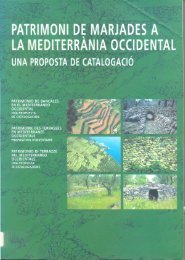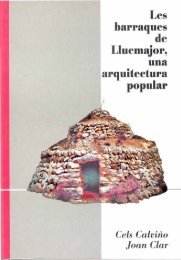La pedra en sec. Materials, eines i tècniques tradicionals a les illes ...
La pedra en sec. Materials, eines i tècniques tradicionals a les illes ...
La pedra en sec. Materials, eines i tècniques tradicionals a les illes ...
Create successful ePaper yourself
Turn your PDF publications into a flip-book with our unique Google optimized e-Paper software.
***<br />
* * *<br />
** * ** 6 6.4 DRYSTONE MASONRY STRUCTURES<br />
Surface water in Majorca only flows<br />
through intermitt<strong>en</strong>t watercourses due<br />
to the seasonal irregularity of rainfall,<br />
the small size of the island's drainage<br />
basins, and the highly permeable<br />
nature of its rock.<br />
Watercourses on the island, called<br />
torr<strong>en</strong>ts, only have water flowing<br />
through them during periods of heavy<br />
rainfall. On occasions these torr<strong>en</strong>ts<br />
can have extremely high temporary<br />
rushes of water which cause very<br />
destructive flooding The rainfall<br />
responsible for these extreme conditions<br />
oft<strong>en</strong> totals more than 100 mm in<br />
a day or occasionally 400 mm in a<br />
day. This ph<strong>en</strong>om<strong>en</strong>on is especially<br />
frequ<strong>en</strong>t in the mountainous areas.<br />
Giv<strong>en</strong> these conditions, it was<br />
necessary to build drystone masonry<br />
structures basically designed to prev<strong>en</strong>t<br />
soil erosion by water runoff and<br />
to regulate drainage in order to make<br />
farming possible. The most common<br />
practice was to channel the torr<strong>en</strong>ts<br />
betwe<strong>en</strong> drystone walls following their<br />
natural course and simply placing<br />
retaining walls on both sides of the<br />
main riverbed to stop the flooding of<br />
the farmland. In other cases, the natural<br />
course of the torr<strong>en</strong>t was made<br />
more geometric so as not to impinge<br />
on the shape of a farm and to <strong>en</strong>able<br />
the bed of the watercourse to be farmed.<br />
Occasionally some stretches of<br />
the torr<strong>en</strong>t were covered with new soil<br />
to obtain larger fields.<br />
In the most extreme cases an artificial<br />
channel (raWa) was built to divert<br />
the water to the fields. This diversion<br />
could be towards one side of the valley<br />
bottom, towards the exterior part<br />
of the farmland, towards karst absorption<br />
features (av<strong>en</strong>cs or potho<strong>les</strong>), or<br />
towards another basin going over a<br />
relief feature. A large part of waterrelated<br />
structures are to be found in<br />
terraced fields and give rise to constructive<br />
singularities produced by the<br />
pres<strong>en</strong>ce of the terrace walls. If the<br />
channels run at right ang<strong>les</strong> to the<br />
walls and are built into their structure,<br />
the bed has a stepped profile with a<br />
series of small waterfalls.<br />
Small bridges were built across<br />
these channels, walls arranged as if<br />
they were funnels to collect and direct<br />
the water to the channel, stretches of<br />
channels were put underground in<br />
mines (underground passages), etc.<br />
It is common practice on the island<br />
to invade the natural course of a river'<br />
in this way the river beds and valle~<br />
bottoms can be completely giv<strong>en</strong> over<br />
to farmland. The method used is to<br />
interdict the streambed with a series<br />
of walls standing at right ang<strong>les</strong> to the<br />
course of the river (parats), which<br />
support flat cultivated areas. These<br />
walls usually <strong>en</strong>joy certain features to<br />
increase their resistance to water<br />
pressure: curved <strong>sec</strong>tions, a highly<br />
reinforced bra6 (double wall) raised<br />
above the level of the field, and<br />
facings made with large stones and<br />
quite op<strong>en</strong> joints.<br />
Other water structures include the<br />
albellons, drainage systems in the<br />
shape of underground galleries,<br />
which collect infiltration water and<br />
remove it from the field or to watercourses.<br />
The land on the Majorcan<br />
Pia (Plain) and a large part of the<br />
island's terraced fields are systematically<br />
drained using this system.




